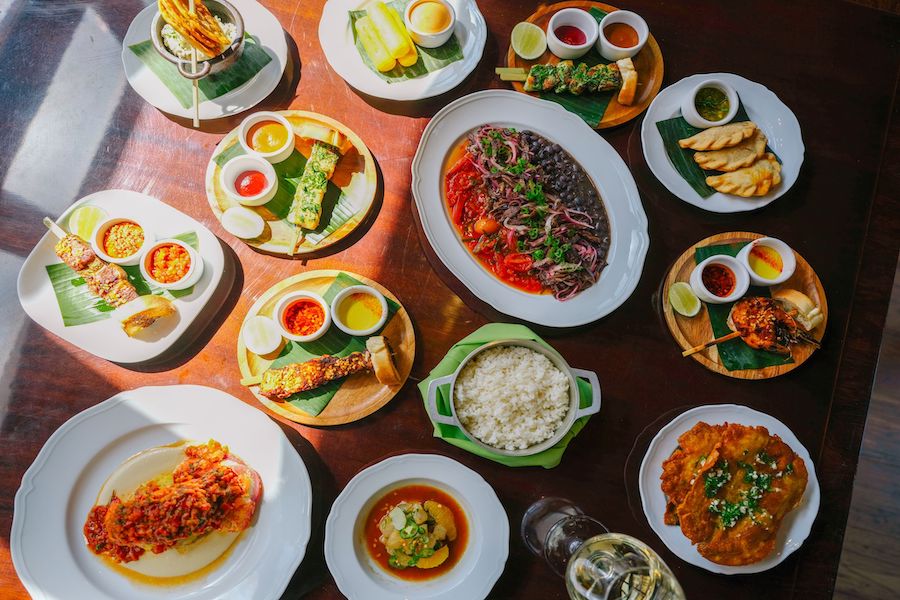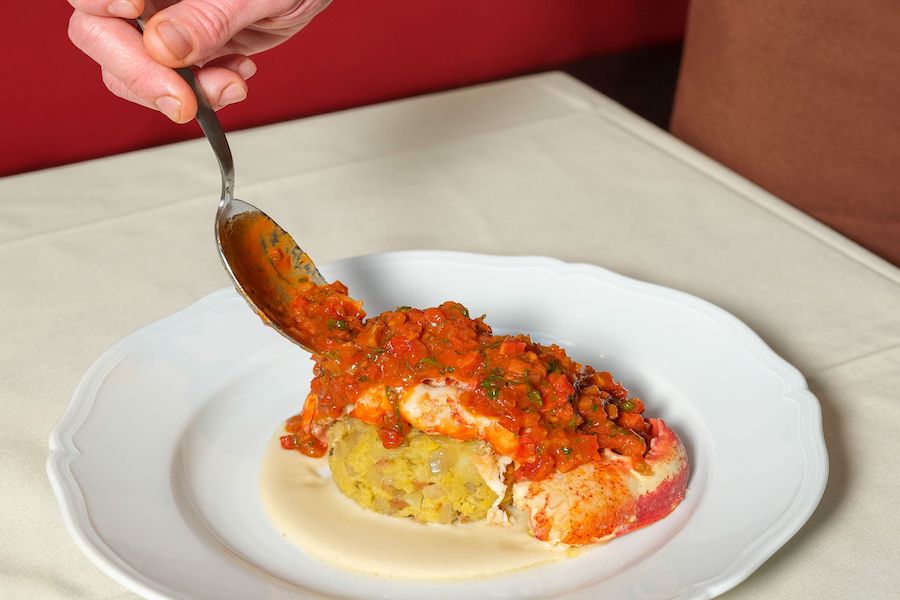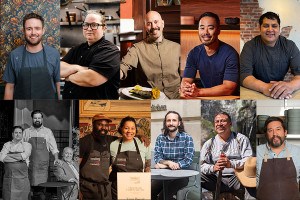For Chef Yun Fuentes, Bolo Is Personal
His new Latin American restaurant and rum bar opens on Friday, April 14th at 2025 Sansom Street with a menu of ceviche, piscolabis and more.

Chef Fuentes at Bolo / Photograph by KC Tinari
When chef Yun Fuentes was growing up in Puerto Rico, he’d often spend time with his abuela, a beautician with her own beauty parlor business behind her home in Río Piedras. Before or after appointments, Fuentes’s grandmother’s clients would sit on the property’s marquesina, a covered outdoor garage area that’s commonly found in Puerto Rican homes built in the mid-20th century.
Soon, the marquesina at Fuentes’s grandmother’s house began to look less like a waiting room and more like a full-on party. Ladies with rollers in their hair would pass around pitchers of sangria and cups of coffee, patient husbands and chauffeurs would drink Cuba libres with key limes floating on top. “People just started coming and hanging out,” Fuentes says. “My grandfather started serving people little snacks here and there, because they were in his house. It’s impossible for us to not host. It’s in our culture.” This was Fuentes’s first exposure to that spark that so often hooks chefs into the business of restaurants — creating a space for strangers and friends to gather that wouldn’t otherwise be possible without food and drinks.
Bolo, Fuentes’s new restaurant opening tonight at 2025 Sansom Street, is designed to emulate his family’s marquesina. Through a menu of rums, cuchifritos, ceviche and piscolabis, he says he hopes to preserve the legacy of his (and many others’) Latin American heritage so those stories don’t get lost. “I feel that my drive has always been the story, and the people, the hands, and the respect for that work,” Fuentes says. “In the culinary realm, there’s sustenance, but then there’s that other thing that you believe in, right?”

A spread of Latin American dishes at Bolo, which opens today in Rittenhouse. / Photograph by KC Tinari
Prior to opening Bolo, Fuentes worked as the culinary director of Milkboy, where he met Bolo business partners Jamie Lokoff and Tommy Joyner (who own the coffee shop and music venue). During Fuentes’s tenure in Philly, he was also the chef de cuisine at Tinto and Village Whiskey, and the executive chef at Alma De Cuba.
But Fuentes’s career all started with an obsession over fine dining. As a teenager, he was working at a deli in Old San Juan that sold specialty goods when he first discovered truffles and pâté.“It just gave me this curiosity of what else is out there and what else I can eat.” Then, during his last semester of college, where he was studying telecommunications and cinematography, he dropped out to climb his way up the brigade system in Puerto Rico’s restaurants. At the time, Fuentes and his chef friends feverishly absorbed anything about Chefs with a capital C: “All I had was the little knowledge that would somehow make its way all the way to San Juan … You would hear about chefs like Alain Ducasse or Alain Passard or Michel Bras. We would eat that stuff up. I remember going to the bookstore and getting a cookbook from a chef, not like a homecook. It was such a big deal for us. We would wait for it like people wait for sneakers now. We were waiting for the cookbook to drop.”
In the early aughts, Fuentes moved to New York and landed a job cooking at Patria — a restaurant opened by the Cuban American chef credited with founding the Nuevo Latino dining movement and one of Fuentes’s culinary heroes, Douglas Rodriguez. (Back when Fuentes was a line cook at The Parrot Club in Old San Juan, he cut out the New York Times’ three-star review of Patria from the newspaper and taped the clipping above his station.)

Bacalaitos / Photograph by KC Tinari
At Patria, Fuentes saw the Latin dishes he’d grown up with being treated with the same level of precision typically reserved for French food in French kitchens or Italian food in Italian kitchens. That ethos stuck with him: “I was able to serve the food of my people on a high, tall pedestal,” he says. ”I feel horrible saying this, but, at one point, I didn’t even know it was able to be done. It was just like, ‘Why would people care about rice and beans?’ To me, the high cuisines were French or Italian. You couldn’t be this big chef who didn’t do that. But then there are so many other people in the states that just kept pushing for other cuisines and other tastes and other looks into what food was.”
In some ways, Bolo is Fuentes’s continuation of chef Douglas Rodriguez’s legacy — his own attempt to center the cooking techniques and traditions prevalent all across Latin America.
Fuentes says he intentionally sought out a restaurant space in Rittenhouse so Bolo could be in the middle of the city: “We don’t have to live on the outskirts. We want to be present.” When he, Lokoff, and Joyner found the two-floor space on Sansom Street (formerly Starr’s Il Pittore) Fuentes says its facade reminded him of some of the 500-year-old buildings in San Juan.
While Bolo’s food will certainly show off Fuentes’s Puerto Rican heritage, the menu is inextricably connected to a range of Latin American cultures. “The food that I was raised with in Puerto Rico already had other Latin American cultures intertwined in it. Cuban food is there. Dominican food is immensely there … They’re part of our story as a restaurant.”

Lobster mofongo / Photograph by KC Tinari
The dining room at Bolo seats 60 guests, with a big skylight, portraits on the walls and plants galore. Guests will have the option to choose between a la carte service or a “tour of the menu” tasting ($55 or $75 per person, respectively).
Bolo’s menu highlights a variety of ceviches, which Fuentes says he became obsessed with while working at Patria in New York, as well as smaller snacks — think lamb picadillo empanadas, pinchos covered in aji de mojili sauce, and pickled mussels inside cups of tostones. As far as entrees go, expect dishes like caldo santo, skirt steak with sweet plantains and black beans, and lobster mofongo with lardo and green plantain timbale and mojo isleño.
“Look, I think that everybody drove fusion cuisine up to where it needed to go. But we all still love to find those parallels and how we intertwine one thing with the other, without clash. Which, in a big way, is how I feel about Latin American cuisine. We, as a people, became who we are because of clashes of culture. You can see why we make sancocho or mondongo or these things that are of African descent. We talk about it, we say it like it’s our own. Maybe the story of how it came to us is not being told, but the seed is there in that culinary journey. We did not lose our heritage, ever. It just kept passing on in this other language. The beauty in that, I don’t have a way of expressing.”

Mojito / Photograph by Lexy Pierce
Just as essential to the Bolo experience as the Latin food, perhaps, is the rum. The restaurant’s first floor features a rum bar with 25 seats, including eight seats at the bar and another eight seats by the big, open windows in front. “Rum is so punk rock. There are no rules. In the islands, we make our own rums out of fruit. We still call it rum even when it’s not technically rum,” Fuentes says. “That’s where the challenge for the cocktail connoisseur comes in. Because you’re dealing with such a rebel spirit that’s doing its own thing constantly in every different brand or bottle.”
Fuentes brought on longtime Philly bar veterans Pheobe Esmon and Christian Gaal to help develop the cocktail menu, which highlights rum-based classics like mojitos, piña coladas, and daiquiris, as well as signature drinks that incorporate ingredients from the kitchen (a sofrito daiquiri with: Ron del Barrilito 2 Star Rum, sofrito shrubs, and bay leaf, for example). The duo ran the celebrated cocktail bar Emmanuelle in Northern Liberties and consulted on the opening menu for the tiki bar, The Yachtsman, in Fishtown. (Both businesses have ceased operations.) Bar manager Evan Maffiore is working closely with Esmon and Gaal to curate a rum list ranging from the very-aged to the very young.
Bolo only received approval for their liquor license on opening day. (The team was planning to open as a BYOB, if necessary.) As such, they’re hoping to grow the bar program to offer more than 100 bottles of rum, and allow guests to try any of these options neat, on the rocks, or in the style of Ti’ Punch — especially popular in Martinique and served with a little bit of sugar and a lime wedge so you can add sweetness and acidity to your taste.

Behind the bar at Bolo / Photograph by Lexy Pierce
“This is the food of my people, but not my food,” Fuentes says of Bolo’s concept. “I’m part of it, but I’m not standing alone. I’m one of many.” Still, Fuentes’ restaurant will always be personal to his family and his lived experiences in Puerto Rico and beyond. After all, the place is named after his grandfather’s nickname, the shortened word for abuelo. It’s also the translated Spanish phrase, “tailless rooster.”
“I don’t condone cock fights. But they’re part of the culture [in Puerto Rico],” Fuentes says. “When the gallo bolo goes into the ring, it doesn’t look as majestic as the other ones. It really is the most underdog of the underdogs. That is something that really resonated with me and just Philly. We kinda place ourselves in that underdog spot. I think we are so much larger. The gallo bolo might be seen as an underdog but it’s a winner.”
Bolo is open Monday through Saturday at 2025 Sansom Street, starting at 4 p.m. The kitchen closes at 10 p.m. (the bar will stay open later) Monday through Wednesday. On Thursday through Saturday, the kitchen closes at midnight, with the bar staying open for at least another hour. Brunch service and happy hour to come.

